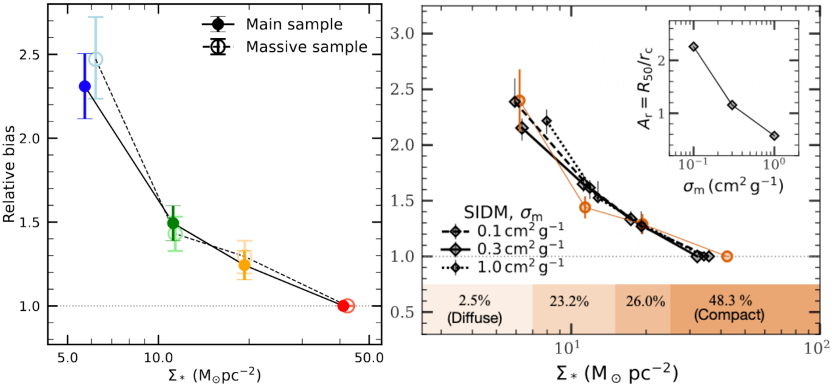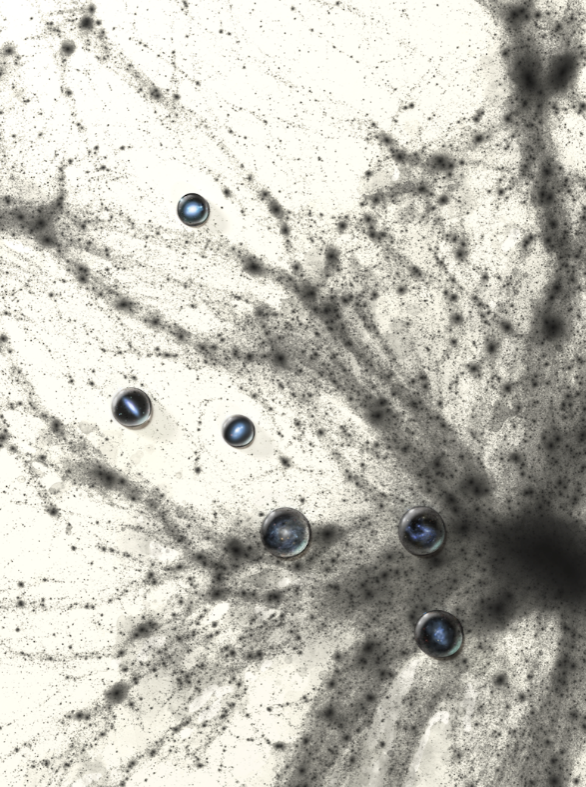A research team led by Prof. WANG Huiyuan from the University of Science and Technology of China (USTC) has made a groundbreaking discovery, identifying for the first time an exceptionally strong clusteringpattern in diffuse dwarf galaxies. Published in the prestigious journalNature, this significant finding poses new challenges to the prevailing galaxy formation models within the Λ-Cold Dark Matter (ΛCDM) framework.
Historically, massive galaxies have served as the primary focus for detectinghalo assembly bias due to their higher luminosity and more efficient observability by surveys such as the Sloan Digital Sky Survey (SDSS). In contrast, dwarf galaxies have often been underrepresented in such studies because of their low luminosity and the challenges associated with sparse sampling.
However, the USTC research team has revealed that dark matter halos hosting dwarf galaxiesalsoexhibit halo bias. Importantly, this bias remains largely unaffected by uncertainties in halo mass estimations. This finding suggests that halo assembly bias may be more effectively traced through dwarf galaxies compared to their more massive counterparts.
In their study, Prof. WANG’ team analyzed a sample of isolated dwarf galaxies from the SDSS, uncovering that diffuse dwarf galaxies display unexpectedly higher large-scale clustering compared to compact dwarf galaxies. This striking spatial distribution pattern presents a fundamental contradiction to the established understanding derived from studies of massive galaxies.

Fig1.The observed relative bias of dwarf galaxies(left); and the relative bias predicted from the ELUCID simulation under the assumption of the Self-Interacting Dark Matter (SIDM) model (the black curve) compared with the observational results (the orange curve)(right).
By utilizingtheir proprietary ELUCID cosmological simulation,theresearchersfound that this "inverted" phenomenon is intrinsically linked to the formation time of halos. Specifically, the spatial distribution of diffuse dwarf galaxies closely aligns with old halos, while compact dwarf galaxies follow patterns similar to young halos.This result delivers the first high-confidence observational support for halo assembly bias through real-world data, bridging a critical gap between cosmological simulations and empirical validation.
However, existing galaxy formation models under the ΛCDM paradigm fail to explain the formation of diffuse dwarf galaxies in old halos, implying potential contradictions between current galaxy formation models and dark matter models and the actual Universe.
To address this discrepancy, theresearchteam introduced the Self-Interacting Dark Matter (SIDM) model. This modelposits that dark matter particles interact not only through gravity but also via weak non-gravitational interactions. These interactions cause structural expansion and weaken the central gravitational strength in old halos,thereby promoting the formation of diffuse dwarf galaxies. Conversely, young halos exhibit weaker such effects, favoring the formation of compact dwarf galaxies. This theory naturally explains the observed "halo age – galaxy density" correlation, suggesting that the nature of dark matter may be more complex than previously anticipated.

Fig2. The large-scale distribution of dark matter in the universebyink-wash art techniques.The water dropletsshow images of dwarf galaxies in different environments, demonstrating the complex correlation between the large-scale structure of the universe and the formation of small-scale galaxies.
Reviewers fromNaturehighly recognized the significance of this work: " This is an original and very surprising (and thus significant) result. Testing predictions of dark matter self-interactions through galaxy clustering is a novel approach and could have a lasting impact."
This research represents the first observational confirmation of significant halo assembly bias—a critical breakthrough that offers unprecedented constraints for unraveling the nature of of dark matter, the evolution of cosmic large-scale structures, and the mechanisms governing galaxy formation and evolution. Crucially, it uncovers a unique correlation between the structures of baryonic components and the ages of their host halos in dwarf galaxies, fundamentally challenging the standard CDM paradigm and necessitating potential modifications.
Paper link:https://www.nature.com/articles/s41586-025-08965-5
(Written by ZHANG Yihang, Edited by ZHAO Zheqian, USTC News Center)